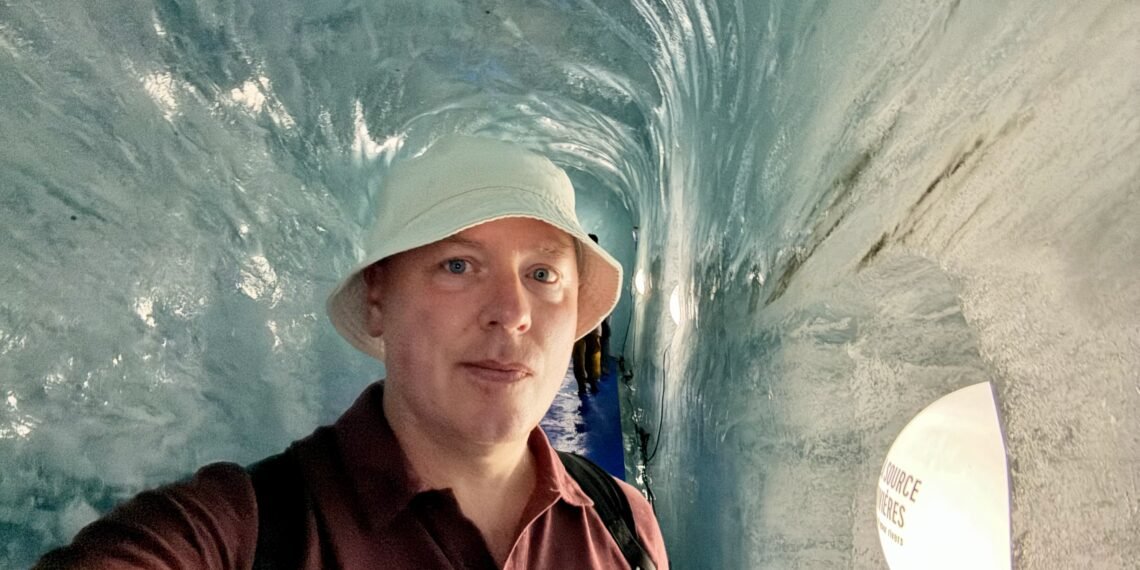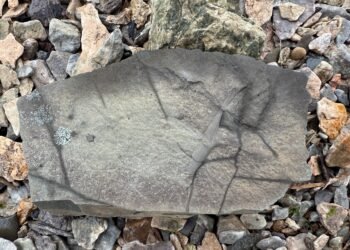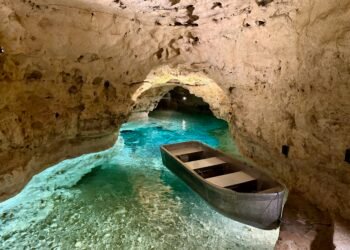Discover the surreal beauty and science of the Grotte de Glace – an ice cave carved into France’s Mer de Glace glacier near Chamonix. In this firsthand account, I explore the glowing blue tunnels of the glacier, uncover the science behind its formation and retreat, and reflect on what this vanishing wonder reveals about our changing planet.
1 A Moment in Time Inside the Grotte de Glace
t’s rare to step into a place that feels both ancient and fleeting. But that’s exactly what I experienced deep inside the Mer de Glace ice cave, known locally as the Grotte de Glace – a stunning ice cave carved into the Mer de Glace glacier, high in the French Alps above Chamonix. This wasn’t just another tourist stop. For me, it was a visceral connection to Earth’s glacial heartbeat – one that’s slowly fading before our eyes.
2 A Return to the Glacier
I first visited the Mer de Glace in October 2021, during my inaugural visit to Chamonix. I remember standing at the overlook, watching the glacier wind its way through the valley like a frozen river pulled taut across the land. Markers along the trail showed how far it had retreated in recent decades, which was a sobering, physical timeline of climate change.
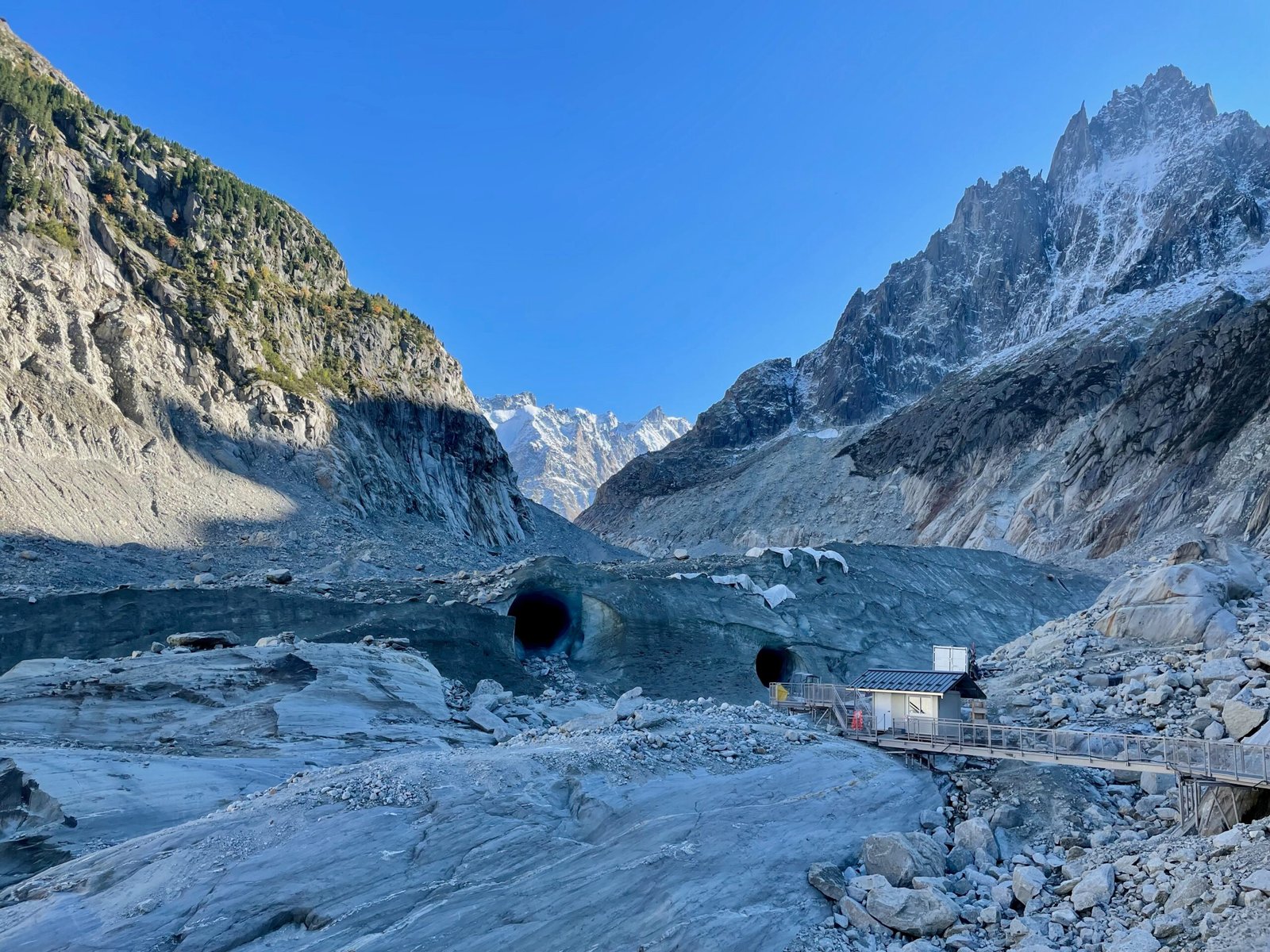
While I explored the glacier’s face during that first visit, the Grotte de Glace was closed. I left with a quiet sense of unfinished business and the hope that one day, I’d return to see it.
That day finally came. On a recent trip to Chamonix, which also included a visit to the iconic Aiguille du Midi – my chance to return to see the Grotte de Glace came again. This time, the cave was open, and I wasn’t going to miss it.
3 Quick Facts About the Grotte de Glace
- Location: Mer de Glace glacier, near Chamonix, France.
- Elevation: ~1,450 metres (4,757 feet) above sea level.
- Length of Ice Cave: Approx. 100 metres (328 feet).
- Ice Age: 200–300 years (with deeper layers over 1,000 years old).
- Glacier Thickness: Up to 200 metres (656 feet).
- Glacier Width: Up to 700 metres (2,296 feet).
- Glacier Movement: Up to 90 metres per year.
4 The Journey to the Glacier’s Heart
Reaching the Grotte de Glace is an adventure in its own right. I boarded the red cogwheel train at Chamonix’s main station – the Montenvers Railway, which has been ferrying glacier visitors since 1908. In about 20 minutes, the train climbed high into the mountains, arriving at Montenvers Station, perched above the Mer de Glace.

From there, I followed signs to a cable car that glided steeply down the valley wall. At the lower station, a long metal gangway led me across the rocky terrain to the glacier’s edge – a descent that grows longer each year as the ice retreats.
From there, I followed signs to a cable car that glided steeply down the valley wall. If you have a Mont Blanc Multipass, this ride is included. At the lower station, a long metal gangway led me across the rocky terrain to the glacier’s edge — a descent that grows longer each year as the ice retreats.
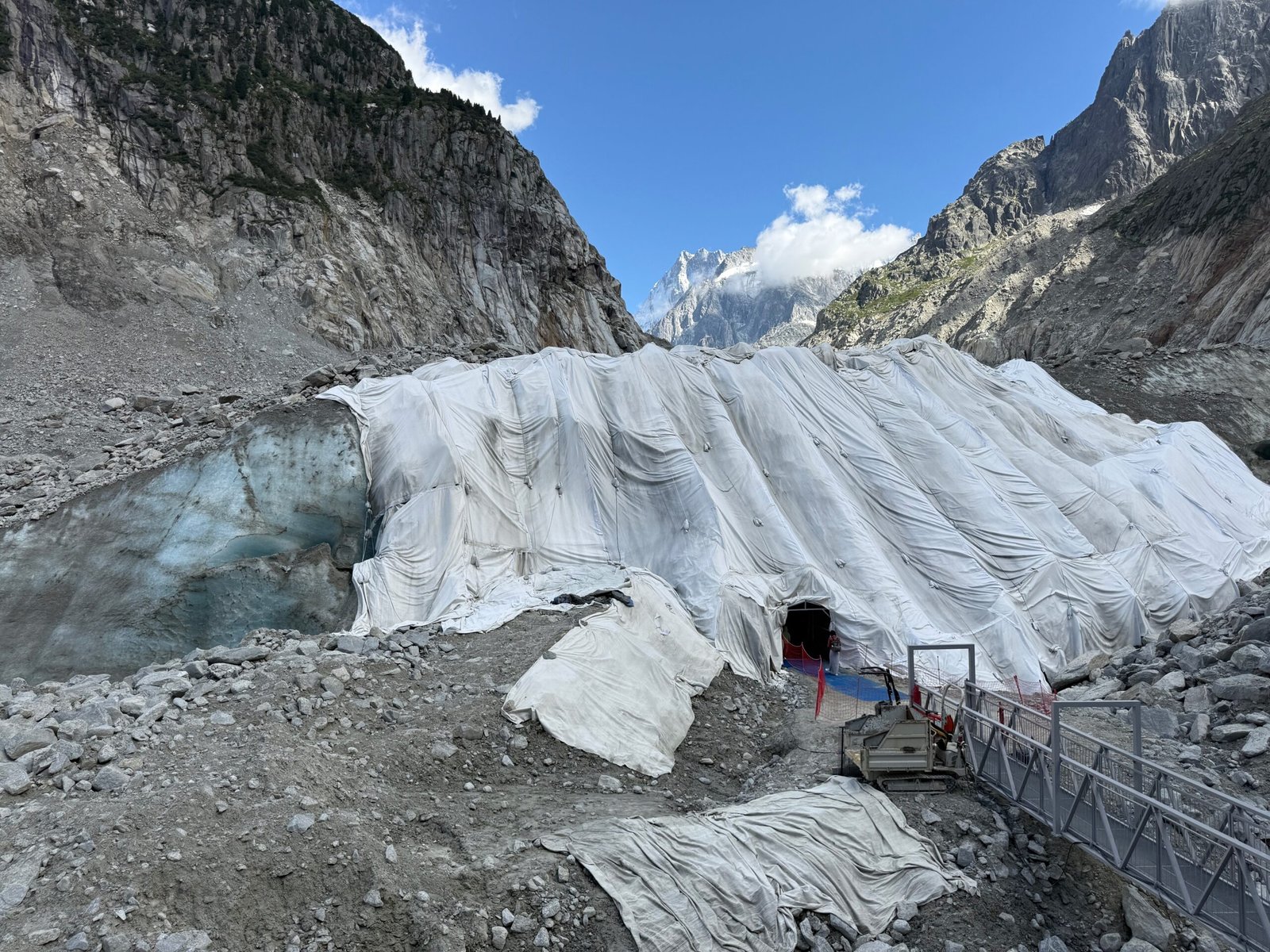
Near the entrance to the cave, I noticed white tarps covering the ice, which was a jarring sight. These tarps are laid out each summer in an effort to slow surface melting. Elsewhere, the glacier is blanketed in rocky debris – remnants of its grinding descent from the slopes of Mont Blanc. But here, the effort to preserve the Grotte de Glace is both scientific and symbolic.
You Might Also Like:
- Aiguille du Midi: An Engineering Marvel Above Chamonix – Discover the geology and altitude science behind this iconic Mont Blanc summit.
- Palvolgyi Cave: Explore Hungary’s Longest Cave System – Descend into a hidden world of geology beneath Budapest
- Mer de Glace: Chamonix’s River of Ice – Learn more about the glacier that houses the Grotte de Glace and its dramatic retreat over time
5 Entering Another World
Stepping into the Grotte de Glace felt like crossing into another realm, like a frozen dreamscape where time and temperature move differently.
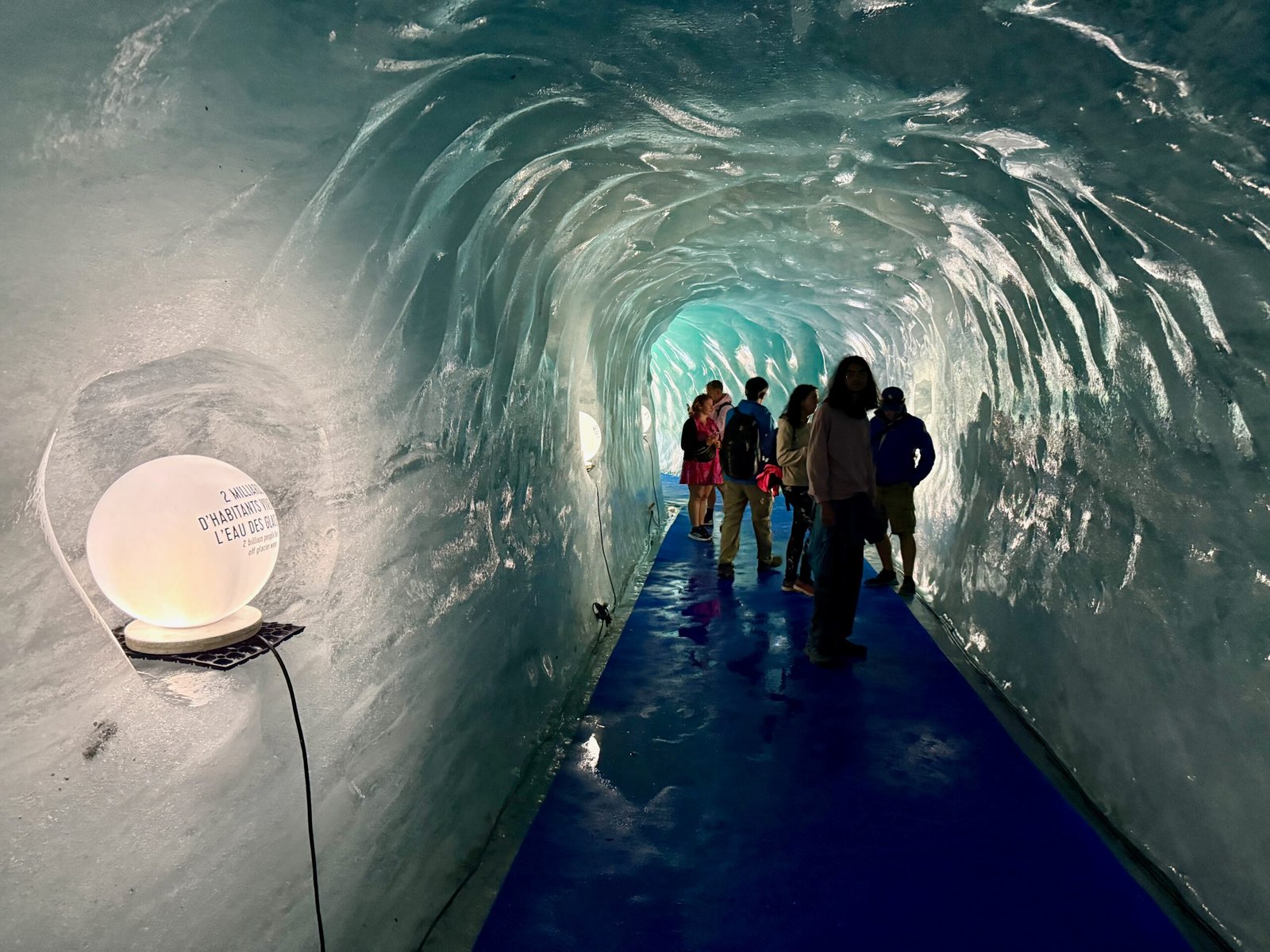
The tunnel walls glowed with shades of turquoise and icy blue, illuminated by ambient light that shimmered through the glacier’s dense mass. The deeper I walked, the deeper the blue. It was hauntingly beautiful.
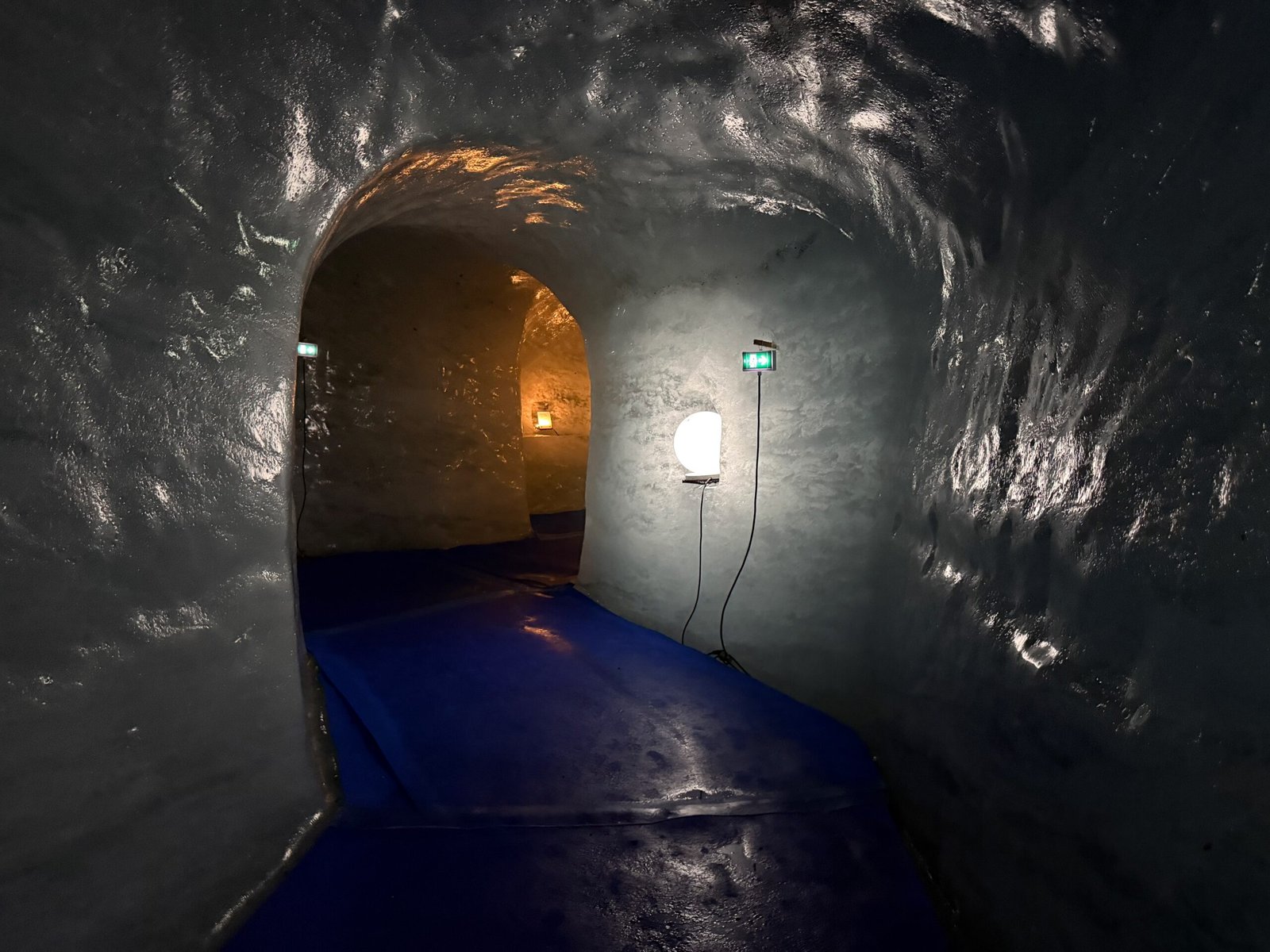
I reached out and touched the smooth, polished surface. Cold, yes, but timeless too. This ice likely began its life as snowfall hundreds of years ago, slowly compacted over time into the glacier around me. I couldn’t help but wonder: What did the world look like when these crystals first formed? Whose footsteps had never touched this ice until now?

Inside, the air was refrigerator-cool – just chilly enough to warrant a light jacket. The cave floor was lined with blue carpet, providing both traction and a surreal sense of comfort as I wandered deeper into this icy cathedral.
6 Science Beneath the Surface
More than a spectacle, the Grotte de Glace is also a learning space – a living science exhibit carved into one of Europe’s most studied glaciers. As I moved through the tunnel, I wasn’t just walking through ice. I was walking through time, pressure, chemistry, and climate – all suspended in frozen form.
How the Mer de Glace Forms
The Mer de Glace, or “Sea of Ice,” begins its life high on the slopes of Mont Blanc as fresh snowfall. Over time – often centuries, successive layers of snow pile up, compressing the lower layers into dense, compacted ice. This process transforms light, airy snow into a solid mass of crystalline rock, which is the raw material of the glacier.
What many visitors don’t realize is that glaciers are not static. They are dynamic systems that are born of snowfall, shaped by gravity, and constantly moving, even when they seem frozen in place.
A Glacier in Motion
Despite their quiet appearance, glaciers like the Mer de Glace are always in motion. Under their immense weight, the layers of ice deform internally and begin to flow downhill, pulled by gravity. This flow scours and reshapes the bedrock beneath, carving the classic U-shaped valleys you see in alpine landscapes.
In places, the Mer de Glace can move up to 90 metres per year, dragging rocks, sediment, and even massive boulders along with it. This process, which is called glacial plucking and abrasion, acts like nature’s bulldozer, eroding mountain rock and transporting geological material great distances.
A River of Ice, 200 Metres Deep
Standing near the Grotte de Glace, it’s hard to grasp the sheer size of the glacier you’re standing on. At its thickest, the Mer de Glace reaches depths of up to 200 metres – that’s about the height of a 60-storey building. From side to side, it spans nearly 700 metres across in some places, which is as wide as seven football fields.
It truly is a river of ice, slowly carving its way down the valley and reshaping the landscape in its path.
Frozen Time: The Age of the Ice
Inside the Grotte de Glace, many of the glacier’s geological passengers are still visible, such as rocks frozen mid-journey in the tunnel walls. They’re physical evidence of the glacier’s power to erode, transport, and deposit material – a process that has shaped alpine landscapes like this one for many thousands of years, even if the Mer de Glace itself is just a few centuries old in its current form.
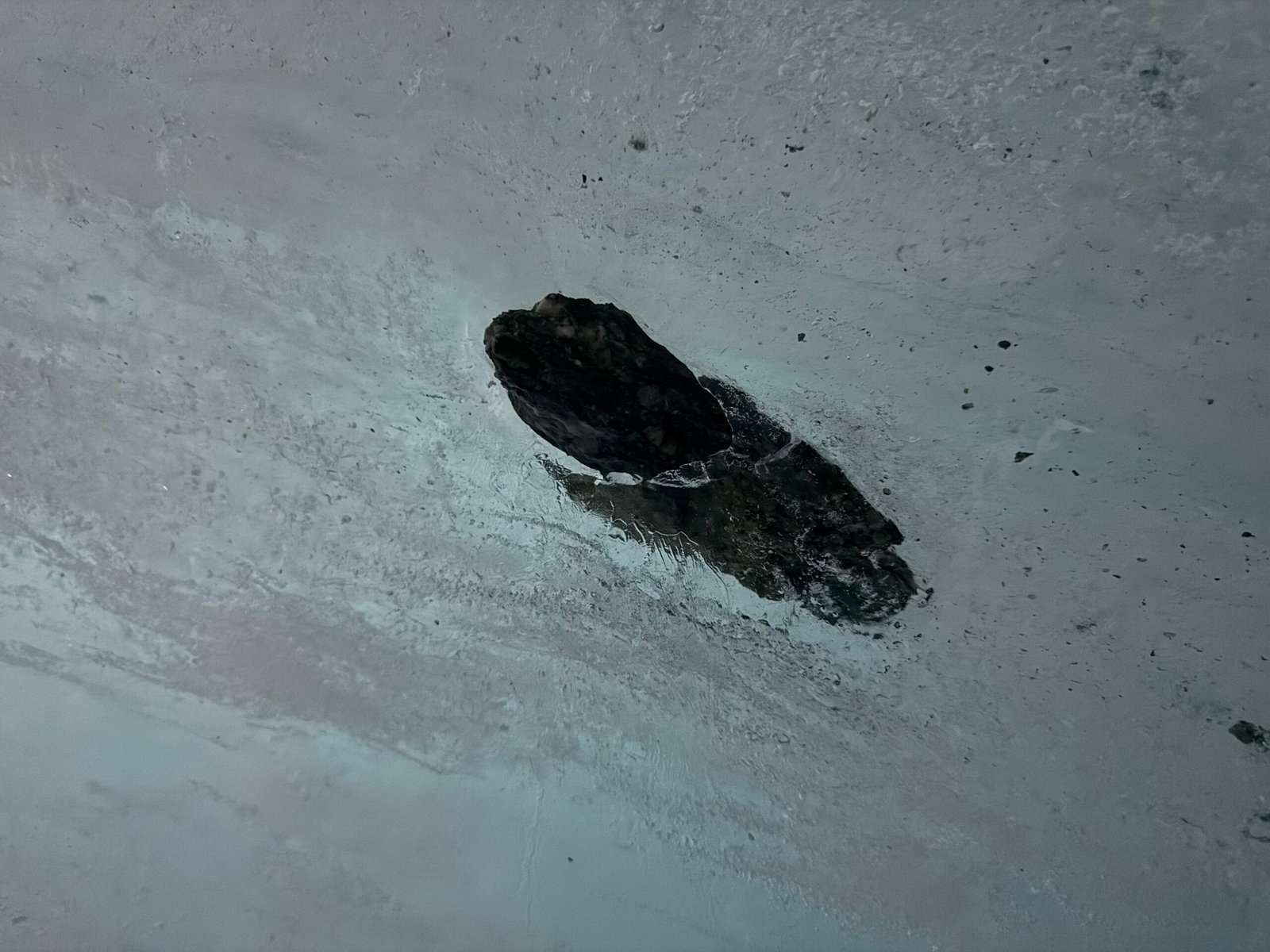
And the ice surrounding them? That’s no ordinary frozen water. The layers near the cave are typically 200 to 300 years old, meaning they likely began as snow falling in the 1700s – before the Industrial Revolution, before airplanes, before climate science. Deeper within the glacier, some ice may be over a thousand years old, preserving ancient air bubbles and chemical traces that serve as a frozen archive of past climates.
Each embedded stone and stratified layer felt like a geologic breadcrumb, linking the cave to its high-altitude origins and to a time long before our own.
Life in the Ice
Along the passageway of the Grotte de Glace, small illuminated panels provide insight into the biology of glaciers – a surprising field in such an extreme environment. One exhibit I lingered on explained the resilience of tardigrades, or “water bears”, which are microscopic creatures known for their ability to survive in the harshest conditions on Earth.

These remarkable organisms can withstand freezing temperatures, radiation, dehydration, and even the vacuum of space. The idea that such hardy lifeforms might be suspended within the glacier’s ice added a touch of biological wonder to this geological experience – a reminder that even in the coldest corners of the planet, life finds a way.
7 A Cave of Wonder and Warning
The tunnel system winds for roughly 100 metres in total length, with the central passage averaging between 2 and 3 metres wide and tall, which is just enough for visitors to walk comfortably through its icy corridors. Several side chambers and alcoves branch off the main path, creating a surreal maze of frozen passageways lit in shades of glowing blue.
I spent nearly an hour taking it all in – reading the scientific displays, photographing the glistening walls, and simply pausing to listen to the quiet timelessness of the ice. The layout may change slightly from year to year, as the entire cave is re-carved each spring while the glacier continues its slow retreat.
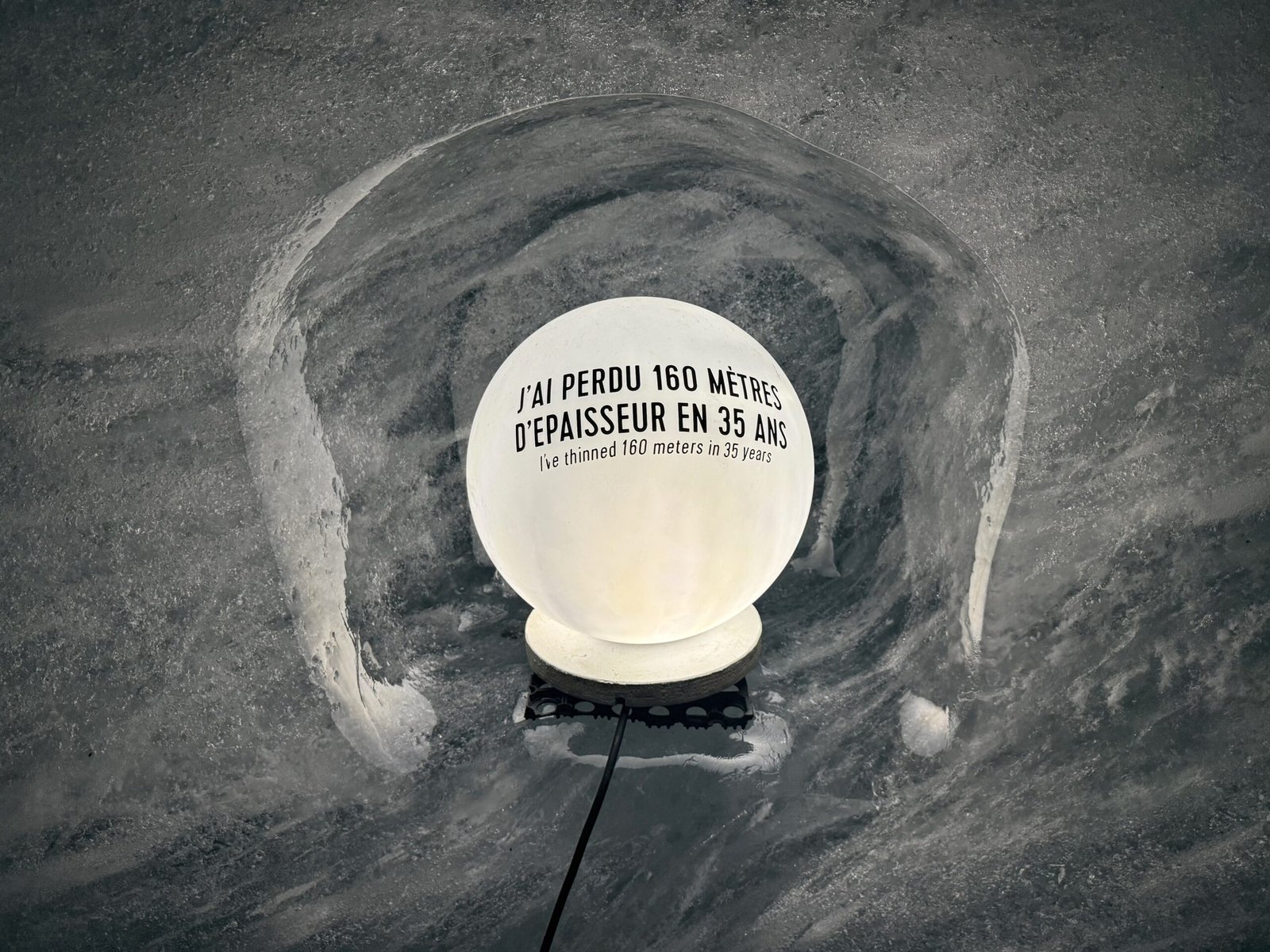
The experience left me with a bittersweet realization. As awe-inspiring as the Grotte de Glace is, it’s also a stark reminder of impermanence. The cave must be re-carved each year, as its previous incarnation lost to melting and movement. What I witnessed during my first visit to the Mer de Glace is already gone. And the glacier that houses it is retreating faster than ever before.
It’s a beautiful place. But it’s also a warning.
8 Practical Travel Tips
Planning a visit to the Grotte de Glace? Here’s what you need to know to make the most of your icy adventure – from train times to what to wear.
- Getting There: Take the Montenvers cogwheel train from Chamonix’s main station (about 20 minutes each way). From Montenvers Station, follow signs to the cable car, which descends toward the glacier.
- Admission: There’s no separate fee to enter the Grotte de Glace. However, you’ll need a valid lift pass, such as the Mont Blanc Multipass, to use the cable car. Alternatively, you can hike down the footpath to the glacier for free.
- Glacier Access: After the cable car, a metal gangway and staircase lead to the Grotte de Glace entrance. The staircase grows longer each year due to the glacier’s retreat — expect a 20–30 minute descent and return climb.
- Opening Season: The cave is typically open late spring through early fall (weather-dependent). Check local listings or the Chamonix tourism website before visiting.
- Clothing: Inside the cave, it’s chilly — around 0°C to 4°C. Bring a light jacket, even in summer.
- Footing: The cave floor is covered with blue carpet for traction, but sturdy shoes are still a good idea.
- Time Required: Allow 2.5 to 3 hours for the full round trip from Chamonix, including train, cable car, stair descent, and cave exploration.
- Last Train: The final train back to Chamonix typically departs around 5:00 PM — confirm schedule before visiting to avoid getting stranded.
9 Pro Tips for the Science Traveler
For those who love to look deeper — here are a few science-savvy observations to enhance your appreciation of the Grotte de Glace as a living natural archive.
- Track the Glacier’s Retreat: As you descend the staircase to the Grotte de Glace, look for year markers indicating where the glacier used to reach. These provide a powerful visual timeline of glacial retreat over the last century.
- Embedded Rocks = Glacial Power: Inside the cave, observe the rocks frozen in the tunnel walls. These aren’t just scenic — they’re evidence of glacial erosion and transport, known as plucking. Each one tells a geological story.
- Glacial Ice ≠ Regular Ice: Touch the walls of the cave — feel how dense and smooth they are. The ice here is centuries old, formed under pressure from compacted snowfall. This gives it a glassy texture unlike freezer ice.
- Ask When the Cave Was Carved: The Grotte de Glace is re-carved each year, and its position shifts depending on how much the glacier has melted. Ask a staff member when it was carved this season — it reveals just how dynamic this “static” glacier really is.
- Compare Old Photos: If you’ve visited before (like I did in 2021), compare your previous photos to today’s — you’ll see noticeable changes in the glacier’s length, color, and surface cover. It’s an excellent case study in real-time climate change.
10 Final Reflections
Eventually, I made my way back up to the cable car and returned to Montenvers Station. A quick note for future visitors: the train back to Chamonix typically runs only until 5:00pm, even in the summer, so be sure to plan accordingly.
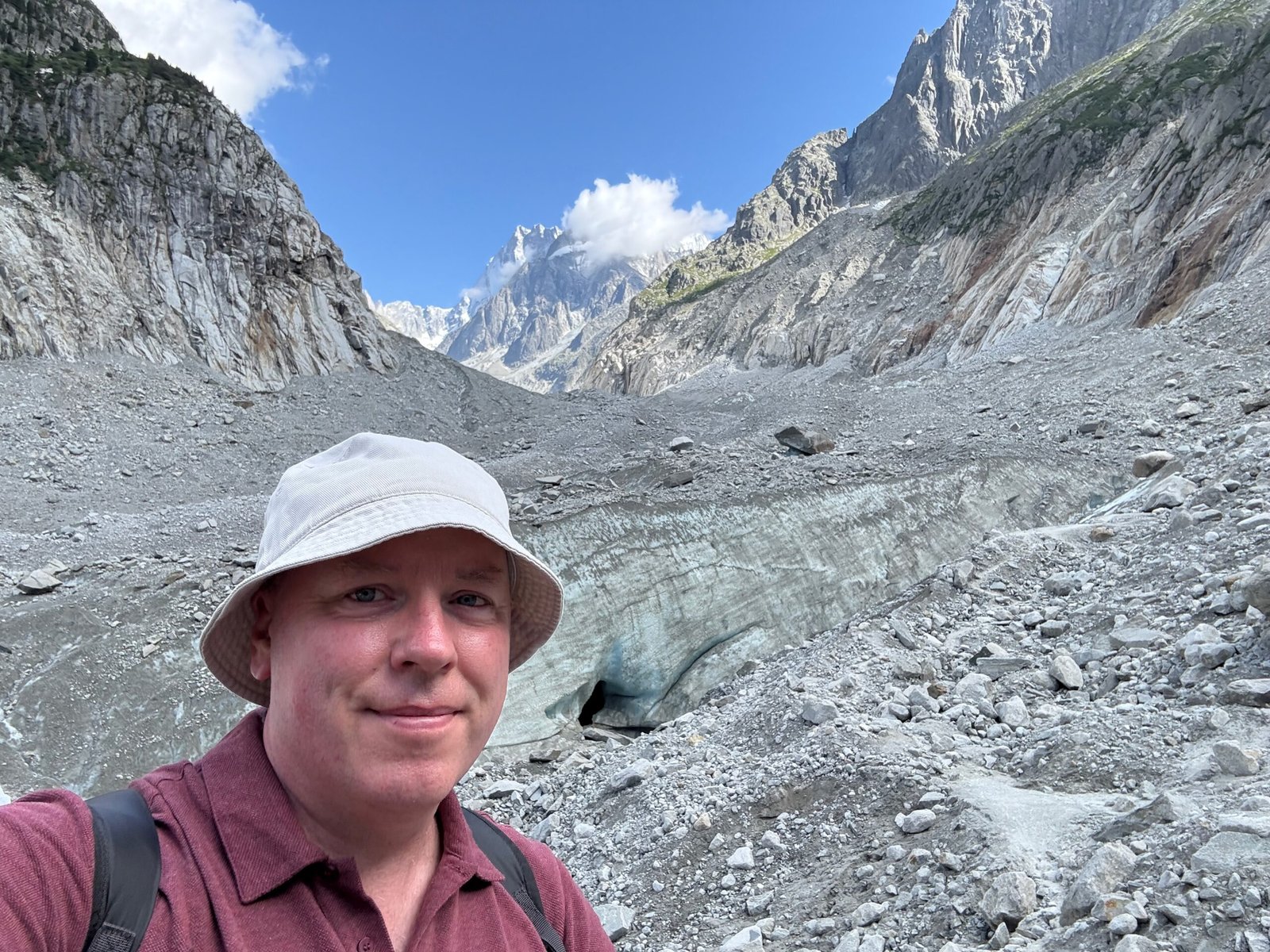
As I ascended back to Montenvers Station and began my return journey to Chamonix, I carried more than just photos. I carried the memory of ancient ice and the sense that I had touched something fleeting – a moment of Earth’s deep history caught between melting seasons.
For science travelers, glacier enthusiasts, or anyone seeking a profound connection to the natural world, the Grotte de Glace is more than worth the journey. It’s not just a cave. It’s a classroom, a time capsule, and a fragile wonder we’re lucky to witness while it lasts.

